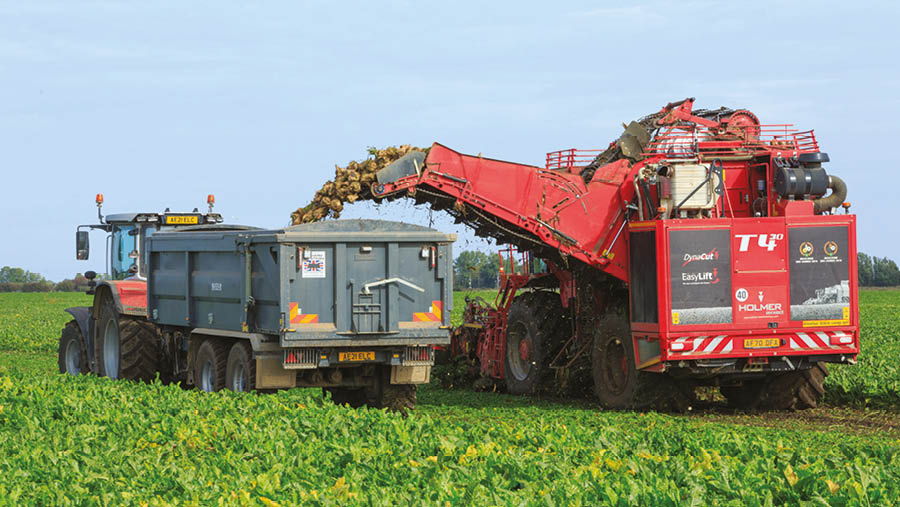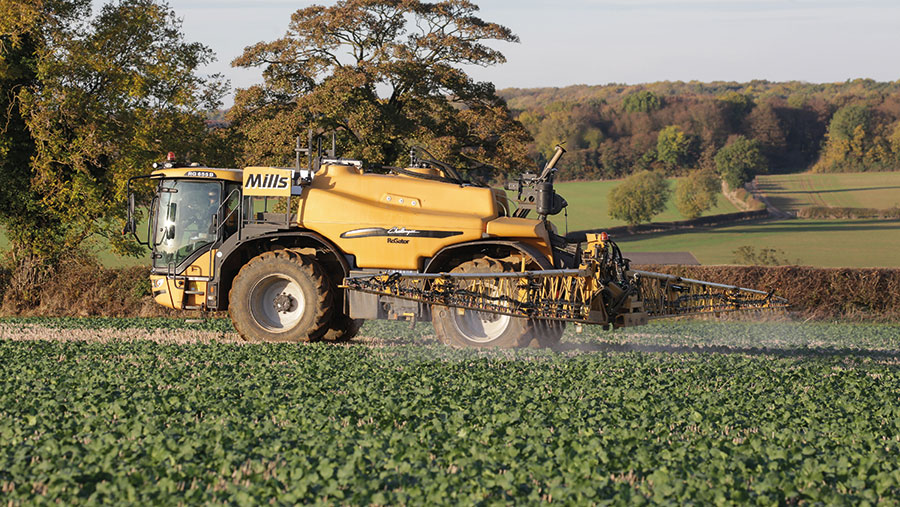Crop Watch: Beet moth problems and blackgrass flushes
 © Tim Scrivener
© Tim Scrivener Weed control is the topic this week with challenges controlling ryegrass in winter barley and blackgrass in earlier-drilled cereals in the drier east.
This is the first season that agronomists can used cinmethylin to tackle blackgrass in wheat while aclonifen makes its debut in winter barley crops.
See also: Farm cuts diesel costs and improves yields in move to regen
West
Stephen Harrison, AICC/Southwest Agronomy (Avon)
Ideal autumn drilling conditions have allowed excellent progress with autumn drilling. Conditions have been such that we have been able to hold off wheat sowing until the middle of the month.
Significant predrilling blackgrass growth received glyphosate and ideal seed-beds means pre-emergence herbicides have every opportunity to perform well.
Early indications show reduced blackgrass emergence in crop, with those plants which have emerged exhibiting chlorosis from the herbicide.
Little crop damage is apparent as seed-beds are well consolidated and drilling depth targets of 32mm have been achieved.
The picture is not so rosy when looking at Italian ryegrass in winter barley, where despite delayed drilling and glyphosate the lack of adequate chemistry to finish the job is apparent.
This comment only applies where Italian ryegrass entrenched in an arable rotation is the target.
Volunteer ryegrass after leys is straightforward to deal with. Early indications of the efficacy of cinmethylin on difficult ryegrass in wheat are encouraging.
Second wheats are likely to be at greater risk from take-all, as many were drilled when soils were above the critical temperature of 12C. Latitude (silthiofam) seed dressing is essential in these circumstances.
OSR herbicides
Talking of temperature, it is still far too early to contemplate propyzamide sprays on winter oilseed rape.
T-sum 170C has been reached in some barley crops and occasional bird cherry aphids are present, therefore, pyrethroid insecticides are now being applied (obviously not on tolerant varieties).
Oilseed rape which survived the difficult establishment period is moving on strongly, with many crops at six or more leaves. Currently, entry scars from cabbage stem flea beetle larvae are difficult to find.
Recent rainfall has aggravated the phoma risk, struggling small crops are most at risk.
Larger canopies with low levels of lesions are unlikely to benefit, as the longer petioles mean the fungus has less time to move through the plant.
Finally, winter oats are now at one-to-two leaves stage and most winter bean crops have now been drilled.
East
Becky Finbow, Agrovista (Norfolk/Suffolk)
Autumn 2022 here we are and so far, so good in Suffolk and Norfolk.
Most of the oilseed rape crops were drilled slightly later this year due to the lack of moisture, and have managed to escape any fatal flea beetle damage.
Earlier-drilled crops, especially those sown at a low seed rate, have been less successful, with many being lost to both pigeons and flea beetle.
In terms of aphids, I have yet to see any on the underside of leaves, but checking regularly is advisable considering the mild conditions.
Cereal volunteers and grassweeds have been taken out with either a graminicide or Centurion Max (clethodim), with blackgrass-affected fields likely to get a Kerb (propyzamide) application once temperatures drop.
Beet moth
The infestation of beet moth in sugar beet crops has encouraged farmers to get their beet out of the ground earlier to prevent further damage.
Although this is ideal, practically it is proving more difficult, with factories and hauliers both being limiting factors.
Yields have been disappointing so far, but the hit has been tempered by reasonable sugars, some as high as 20%. It is also important to note that most of the better crops are still waiting to be harvested.
In the cereal world it is nice to have some new chemistry on the scene. It is the first year of using Luximo (cinmethylin), and Proclus (aclonifen) is making its debut on winter barley, and I hope both will do a reasonable job on tricky grassweeds.
However, the mild, dry conditions and the lack of stale seed-beds pre-drilling is really going to test these new products, as I am starting to see blackgrass already on earlier-drilled cereals.
Aphids are also out enjoying the autumn sunshine and can be seen readily on cereal crops. Setting yellow sticky traps or counting the T-sum will provide an indication of when a barley yellow dwarf virus spray will need to be applied.
Along with a BYDV spray, a top-up application of flufenacet, diflufenican and/or pendimethalin is being recommended to maintain the soil’s residual layer and help suppress further grassweed emergence.
South
Jamie Swift, Procam (East Sussex)
What a time to be heading into a new growing season. There doesn’t seem to be any aspect of farming that hasn’t been affected by world events and price rises.
The hottest summer in 40 years saw harvest come to an end remarkably early, and also put a stop to a lot of planned early oilseed rape drilling.
OSR crops drilled mid-to-late August suffered from the lack of rain which led to some crops being either abandoned or re-drilled.
The rain did finally arrive in September here in the south – supplying 100mm, double the average for the month!
This encouraged growth just in time to help mitigate the worst of the flea beetle damage once migration started in early September, and crops are looking well with most now at the four-to-six leaf stage.
Integrated pest management is key in the battle against cabbage stem flea beetle, and I’m seeing real benefits from using companion crops to effectively disguise the crop from the pest with rapidly growing plants such as buckwheat and strong smelling plants such as fenugreek.
From a disease perspective, phoma and light leaf spot are the ones we most commonly think of, but powdery mildew is also appearing in a lot of crops – likely aided by the dry weather. An application of Propulse (prothioconazole + fluopyram) is a strong control option here where thresholds are met.
New herbicide
This autumn has seen the arrival of the much-anticipated active ingredient cinmethylin – AKA Luximo. Despite showing real promise in trials compared with flufenacet, a new active doesn’t mean we should through caution to the wind!
Implementing the same IPM principles we’ve learned over the years will be as important as ever to protect this new tool.
Despite these well-known principles, there are scenarios where the eagerness to drill in case the rain arrives and “never stops” has resulted in residuals being applied to dry seed-beds.
As a result, grassweeds are now germinating in full force and the visual reminder of why we encourage delayed drilling is stark.
For these, the writing is on the wall and the first loss is often the best, so we’ll be turning to glyphosate and more wheat seed.
Those who haven’t rushed should see good performance from residual stacks, with good drilling conditions meaning seed-beds are excellent, and the arrival of moisture giving stacks a fighting chance.
North
Mary Munro, AICC/Strutt and Parker (Perthshire)

© Tim Scrivener
It is a real pleasure to walk across farms just now. Autumn sowing is almost finished; there are some fields of wheat to go in after potatoes but, for the most part, the bulk of the work is done.
We were fortunate to have more moisture at sowing than growers further south, so the OSR crops were drilled promptly in August.
They are well-established with the early herbicides on (pre- or early post-emergence, plus graminicides) and just the Kerb (propyzamide) to apply once temperatures drop.
We are still experiencing night temperatures around 10C and daytime temperatures well into the teens, so I would like to wait for colder conditions before spraying propyzamide.
There is little or no disease present and my growers will wait till spring before applying a fungicide for light leaf spot.
The winter barleys are tillering nicely and the herbicides have gone on as planned.
Although waiting for cooler temperatures for Kerb, the weather is certainly too inhospitable for much aphid activity and this is no longer a matter to debate.
At this time of year, wheat crops range from tillering to not yet sown.
Fortunately, blackgrass is not an issue for us, and although there are some farms that have found it, it is not a field-scale phenomenon and generally dealt with using glyphosate spot treatment.
Brome problem
Bromes are much more of a concern, especially for those growers who avoid ploughing, and a more planned approach may be required.
My basic starter herbicide is Liberator (diflufenican + flufenacet) or similar, plus a picolinafen/pendimethalin product, which does a good job.
Broadway Star (florasulam + pyroxsulam) is a great follow-up, but we wait until spring, as we cannot rely on the weather allowing another pass, and nothing is so bad that a third targeted brome spray is necessary.
I watch with alarm as the populations of resistant ryegrass increase and head north. This is a problem we really do not want.
East Lothian has few farms with grass in the rotation, but it is a regular crop in Fife, Perth and Aberdeenshire. It may not fit well with the philosophy of regen agriculture, but ploughing remains an essential part of the armoury.

